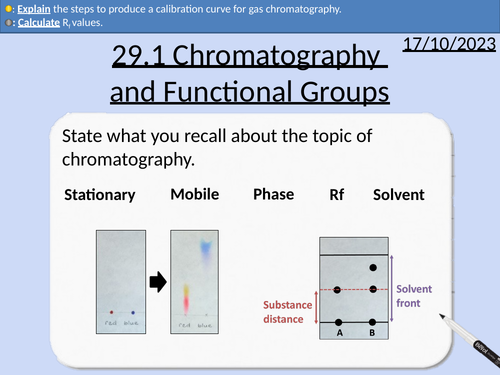
OCR A level Chemistry: 29.1 Chromatography and Functional Group Analysis
This PowerPoint is a whole lesson included with student activities, animated answers, homework questions with answers provided.
This lesson covers:
- Thin layer chromatography (TLC)
- Rf values
- Gas chromatography (GC)
- Gas chromatograms
- Retention time and peak integrations
- Calibration curves from retention time and relative peak area
- Differentiation of functional groups: alkene, primary and secondary alcohols, aldehydes, cabonyl compounds, carboxylic acids, and haloalkes.
Get this resource as part of a bundle and save up to 20%
A bundle is a package of resources grouped together to teach a particular topic, or a series of lessons, in one place.
OCR A Level Chemistry: Module 6 Organic Chemistry and Analysis
This bundle includes all PowerPoint lessons for Module 6 Organic Chemistry and Analysis. All PowerPoints are whole lessons included with student activities, animated answers, homework questions with answers provided. **C25 Aromatic Chemistry** * Introducing Benzene * Electrophilic substitution Reactions * The Chemistry of Phenol * Directing Groups **C26 Carbonyls and Carboxylic Acids** * Carbonyl Compounds * Identifying Aldehydes and ketones * Carboxylic acids * Carboxylic acid derivatives **C27 Amines, Amino Acids and Polymers** * Amines * Amino acids, amides and chirality * Condensation Polymers **C28 Organic Synthesis** * Carbon-carbon bond formation * Further Practical Techniques * Further Synthetic Routes **C29 Chromatography and Spectroscopy** * Chromatography and functional group analysis * Nuclear Magnetic Resonance Spectroscopy * Carbon-13 NMR Spectroscopy * Proton NMR Spectroscopy * Interpreting NMR Spectra * Combining Techniques
OCR A level Chemistry: Chromatography and Spectroscopy
OCR A level Chemistry: Chromatography and Spectroscopy is apart of the Module 6: Organic Chemistry and Analysis. All presentations come with worked examples, solutions and homeworks. 29.1 Chromatography and Functional Group Analysis 29.2 Nuclear Magnetic Resonance (NMR) Spectroscopy 29.3 Carbon-13 NMR Spectroscopyy 29.4 Proton NMR Spectroscopy 29.5 Interpreting Proton NMR Spectra 29.6 Combined Techniques * Thin layer chromatography (TLC) * Rf values * Gas chromatography (GC) * Gas chromatograms * Retention time and peak integrations * Calibration curves from retention time and relative peak area * Differentiation of functional groups: alkene, primary and secondary alcohols, aldehydes, cabonyl compounds, carboxylic acids, and haloalkes. * Nuclear Spin * Resonance * Tetramethylsilane (TMS) * Chemical Shift ẟ * Identifying different carbon environments * The types of carbon environment * The amount of chemical shift ẟ / ppm * Identifying the number of different proton environments * Identifying the types of proton environment and chemical shifts * Integration traces (area of peaks) and relative number of protons * The spin-spin splitting pattern (n + 1) * Predicting proton NMR spectra for molecules * Identifying the number of different proton environments * Identifying the types of proton environment and chemical shifts * Integration traces (area of peaks) and relative number of protons * Percentage yield to determine empirical formula * Mass spectra * Infrared spectra * Carbon-13 NMR spectra * Proton NMR spectra
Something went wrong, please try again later.
This resource hasn't been reviewed yet
To ensure quality for our reviews, only customers who have purchased this resource can review it
Report this resourceto let us know if it violates our terms and conditions.
Our customer service team will review your report and will be in touch.
